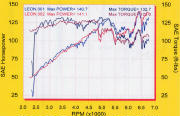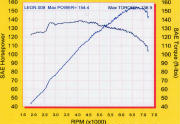Dyno Data
 I first had my car dynoed on 3/11/02 at the Tallahassee Dyno.
Pressure 30.0 inch, humidity 20%,
temperature about 65F (where did I leave the blasted sheet I wrote
them on?) Click on the image to see the results, being a maximum
rear wheel horsepower of 137.7 and maximum torque 125.6.
I first had my car dynoed on 3/11/02 at the Tallahassee Dyno.
Pressure 30.0 inch, humidity 20%,
temperature about 65F (where did I leave the blasted sheet I wrote
them on?) Click on the image to see the results, being a maximum
rear wheel horsepower of 137.7 and maximum torque 125.6.
 The next image shows the power with the supercharger
disabled. (This is pretty much stock, though a couple of horsepower
are absorbed by the freely rotating supercharger.) Results both with and
without supercharger are pretty much as expected (stock 1994-97 Miatas
tend to put a little above 100 hp out at the rear wheels, a very different
number than engine hp provided by the manufacturer, and the
supercharger should add about 40% power.) Though both results are
relatively low. Note however that you should not compare results from
different dynos. Also note the wavy nature of the curves: power
is fluctuating up and down.
The next image shows the power with the supercharger
disabled. (This is pretty much stock, though a couple of horsepower
are absorbed by the freely rotating supercharger.) Results both with and
without supercharger are pretty much as expected (stock 1994-97 Miatas
tend to put a little above 100 hp out at the rear wheels, a very different
number than engine hp provided by the manufacturer, and the
supercharger should add about 40% power.) Though both results are
relatively low. Note however that you should not compare results from
different dynos. Also note the wavy nature of the curves: power
is fluctuating up and down.
The guy who ran the place told me that my
engine is running lean with the supercharger, which he believes is
causing the wavy power curve with the supercharger due to detonation.
I think it might be the J&S knock sensor kicking in and retarding the
timing, robbing power. (See the difference in air/fuel ratios in the
two images above.)
 Another dyno test 6/4/02 at another dyno.
Dynolab in Marietta, near
Atlanta GA,
target of various car club events.
They give you a nice printout with a picture
of you at the test.
The day of the test was low 90s in peak
temperature, but less at the test which was at 9 am.
The graph show the results using my preferred
setup (run 001) with timing at 12 deg BTDC (allowed because
of the J&S) and run 002 has timing at about 7 degrees.
(Set without connecting Ten to Grnd).
Another dyno test 6/4/02 at another dyno.
Dynolab in Marietta, near
Atlanta GA,
target of various car club events.
They give you a nice printout with a picture
of you at the test.
The day of the test was low 90s in peak
temperature, but less at the test which was at 9 am.
The graph show the results using my preferred
setup (run 001) with timing at 12 deg BTDC (allowed because
of the J&S) and run 002 has timing at about 7 degrees.
(Set without connecting Ten to Grnd).
Like the Tallahassee guy,
this operator too was very explicit that the engine was not
working right. In addition to the J&S retarding, the tension
on the supercharger belt was not right, which may have played a part.
But according to people I have talked to, the J&S timing retard
may be the main factor reducing power.
Note that the power here is read as 141, instead of 138 hp in Tallahassee,
suggesting that dynos are indeed different. This dyno seems to be doing
less smoothing: see all those fluctuations in power.
Hector at R-Speed told me they have stopped selling the J&S because of the
power loss. Still, I had no regret getting mine. My experience was that
it improved general drivability by being able to advance timing.
It also allowed
me to drive in many less than ideal circumstances with some confidence,
by for example being able to compensate for oxygenated gas by turning the
sensitivity up. New solutions such as the Bipes may be better, but
they were not around when I got my SC in 96. And they are not adaptive
(they do not listen whether knock actually occurs.)
 One way or the other, the new kid on the block for me is the Link ECU.
Full control of all engine operations! Installed by R-Speed (not an
easy task, I assure you!) But look at the results in the image.
Power has increased by 13 hp! Same engine, same dyno, only change
is the replacement of the J&S by a link ECU.
One way or the other, the new kid on the block for me is the Link ECU.
Full control of all engine operations! Installed by R-Speed (not an
easy task, I assure you!) But look at the results in the image.
Power has increased by 13 hp! Same engine, same dyno, only change
is the replacement of the J&S by a link ECU.
Moreover, note that the engine power is no longer fluctuating up and
down. A beautiful predictable power all over the rpm range.
 The last image shows the air fuel ratio. The guy at the dyno told me
to shoot for 12.3 air/fuel. I did a pretty good job, not? The difference
between the last two runs is that in run 9, I set the timing two degrees
more advanced. The power is a bit up, torque a bit down. So I decided
I may as well stay with the less aggressive setting (run 8.)
The last image shows the air fuel ratio. The guy at the dyno told me
to shoot for 12.3 air/fuel. I did a pretty good job, not? The difference
between the last two runs is that in run 9, I set the timing two degrees
more advanced. The power is a bit up, torque a bit down. So I decided
I may as well stay with the less aggressive setting (run 8.)
The Link ECU plus bigger injectors is a big additional chunk of money
above the supercharger itself. Acording to Hector, you can get
similar low 150s power with a much cheaper Bipes or similar. But the engine
will still run lean under boost and rich without. With a Link ECU,
it will run exactly right. And I can feel it.
 Another dyno test 12/30/03 at Tallahassee.
Upgraded to the July 2003 chip and redid the tuning.
I had to reduce timing from what is shown here, though.
Another dyno test 12/30/03 at Tallahassee.
Upgraded to the July 2003 chip and redid the tuning.
I had to reduce timing from what is shown here, though.
Return
 I first had my car dynoed on 3/11/02 at the Tallahassee Dyno.
Pressure 30.0 inch, humidity 20%,
temperature about 65F (where did I leave the blasted sheet I wrote
them on?) Click on the image to see the results, being a maximum
rear wheel horsepower of 137.7 and maximum torque 125.6.
I first had my car dynoed on 3/11/02 at the Tallahassee Dyno.
Pressure 30.0 inch, humidity 20%,
temperature about 65F (where did I leave the blasted sheet I wrote
them on?) Click on the image to see the results, being a maximum
rear wheel horsepower of 137.7 and maximum torque 125.6.




